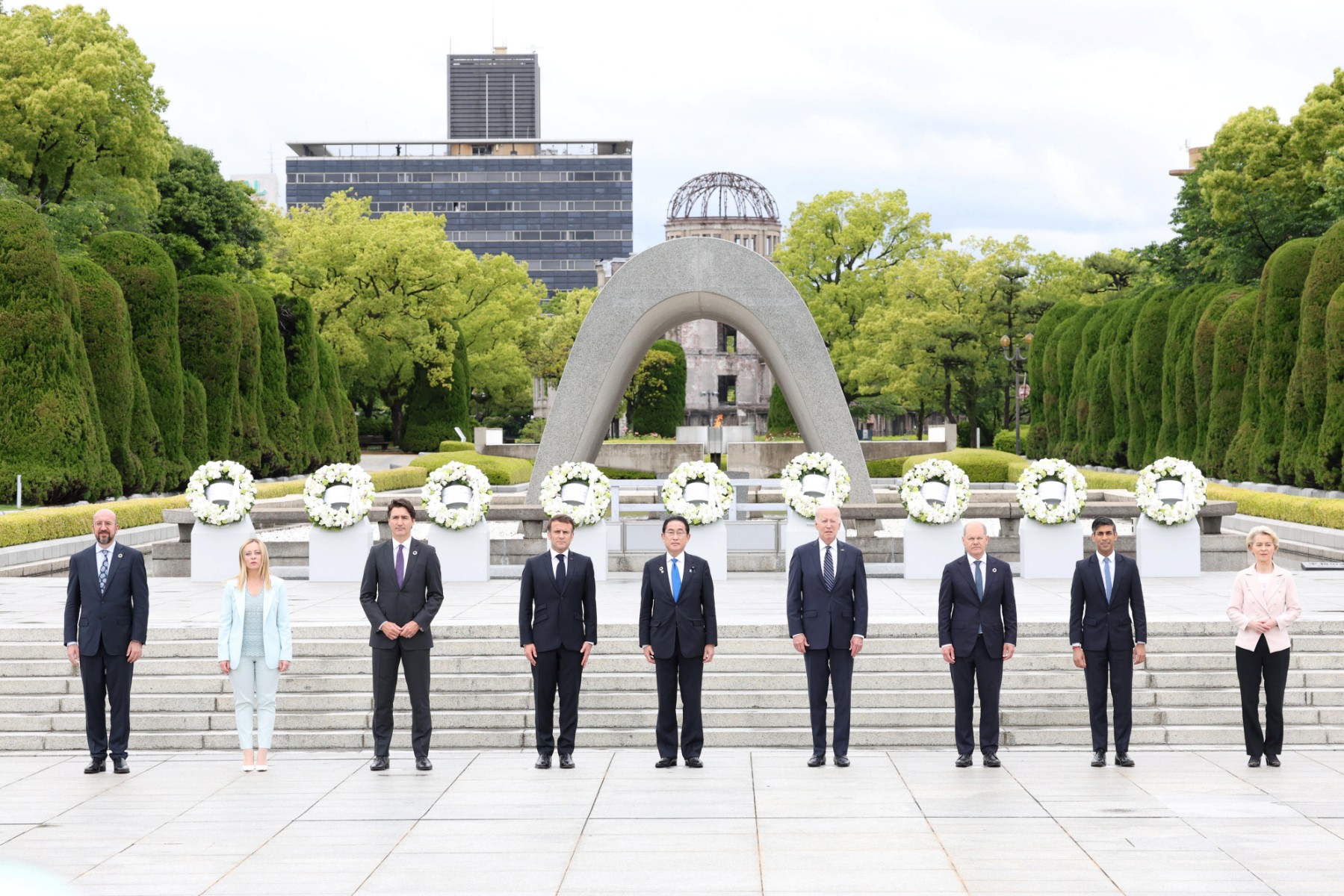Hiroshima, Japan– Under a gunmetal sky and driving rain, leaders of some of the world’s most powerful nations gathered in Hiroshima on Friday to confront the horrors of nuclear weapons.
Earlier, the United States and its G7 allies also rolled out new sanctions against Russia’s “war machine”, targeting Moscow’s lucrative diamond trade and more entities linked to the invasion of Ukraine.
G7 leaders, including the heads of nuclear-armed Britain, France and the United States, arrived at the city’s Peace Park to a sodden red carpet welcome from Prime Minister Fumio Kishida, who is from Hiroshima.
The Japanese leader — whose wife wore a gold pin shaped like an origami crane, an unofficial symbol of the city’s nuclear legacy — wants to put disarmament on the agenda as the bloc holds three days of talks.
Kishida, who once guided then-US president Barack Obama in the city during his historic visit, has said achieving a world free of nuclear weapons is his life’s work.
But while the scene of leaders, including American President Joe Biden, laying wreaths at Hiroshima’s cenotaph was heavy on symbolism, disarmament talks may be light on substance.
Britain, France and the United States alone possess thousands of warheads, and the bloc’s remaining members — including Japan — are covered by Washington’s “nuclear umbrella”.
And there appears to be little appetite to reduce stockpiles elsewhere, with Moscow making thinly veiled threats to use the weapons, China expanding its arsenal and North Korea stoking fears of a new nuclear test with a barrage of missile launches.
Kishida is hoping to convince his counterparts to back his “Hiroshima Action Plan”, unveiled last year, which focuses on transparency around existing stockpiles and a commitment to non-proliferation.
The leaders began their visit with a stop at the Hiroshima Peace Museum, which contains graphic evidence of the devastation and suffering caused by the US nuclear attack on August 6, 1945.
Media were barred from the museum, amid speculation about whether the leaders would visit only the building’s east wing, which describes the dangers of nuclear war, or also pass through the main building, which contains upsetting photos of victims with horrific injuries and heart-rending artefacts including the carbonized tricycle of a child.
By the end of their visit, which lasted around half an hour, the rain had stopped and the sky brightened.
School children handed each leader a wreath of white flowers that were placed simultaneously on podiums before the gentle arching concrete dome of the Hiroshima cenotaph, with its eternal flame and plaque reading: “Let all the souls here rest in peace, for we shall not repeat the evil.”
After a moment of silence, there was a group ceremony to plant a cherry blossom sapling, propagated from a tree that survived the atomic blast.
The leaders were also scheduled to speak with survivors of the bomb, which killed some 140,000 people immediately and in its aftermath, though there were no immediate details.
Speaking to AFP before the visit, survivor Masao Ito, who was four at the time of the attack, said he had a clear message for the group.
“If you have nuclear weapons, you may be tempted to use them, and accidents can happen,” the 82-year-old said. “It’s simply better not to have them.”
“As long as there are nuclear weapons in the world, there is a possibility that your city could become like Hiroshima.”
New sanctions on Russia
Vladimir Putin’s invasion of Ukraine 15 months ago has prompted waves of sanctions that have helped plunge his country into recession and drained the Kremlin’s war chest.
The G7 is now looking to tighten the screws further, strengthening existing sanctions, closing loopholes and subjecting more Russian firms and their international partners to punitive restrictions.
Ukrainian President Volodymyr Zelensky is expected to address the summit over the weekend by videolink, with hosts Japan tamping down speculation he could make a last-minute, in-person appearance.
Washington got the ball rolling on more sanctions early Friday, with a senior US administration official saying 70 more entities from Russia and “other countries” would be placed on a US blacklist.
“And there will be upwards of 300 new sanctions against individuals, entities, vessels and aircraft,” the official said.







